Intergalactic Beacon

The Universe, Reality, and You. Planet Earth where are you?
Greetings Earthlings. First we will discuss our location in the Solar
System relative to the Sun and the other Planets. For a quick refresher
on the Solar System view the Solar System Sketch for Children on the
Intergalactic Beacon. Our Sun is classified as a "Yellow Dwarf Star" and
has a life span of 10,000,000,000 (10 Billion) Years! Our Sun is yellow in
color and is smaller than the average Star in the Milky Way Galaxy. The
Sun is the Center of the Solar System, which is made up of nine planets
including Earth all orbiting the Sun. That is correct, our Sun is a Star
like any other Star you see in the night sky. For the purpose of this
article and to keep things simple, we will not consider the other bodies
that make up our Solar system, such as the millions of asteroids, comets
and other bodies trapped by the Sun's gravitational field.
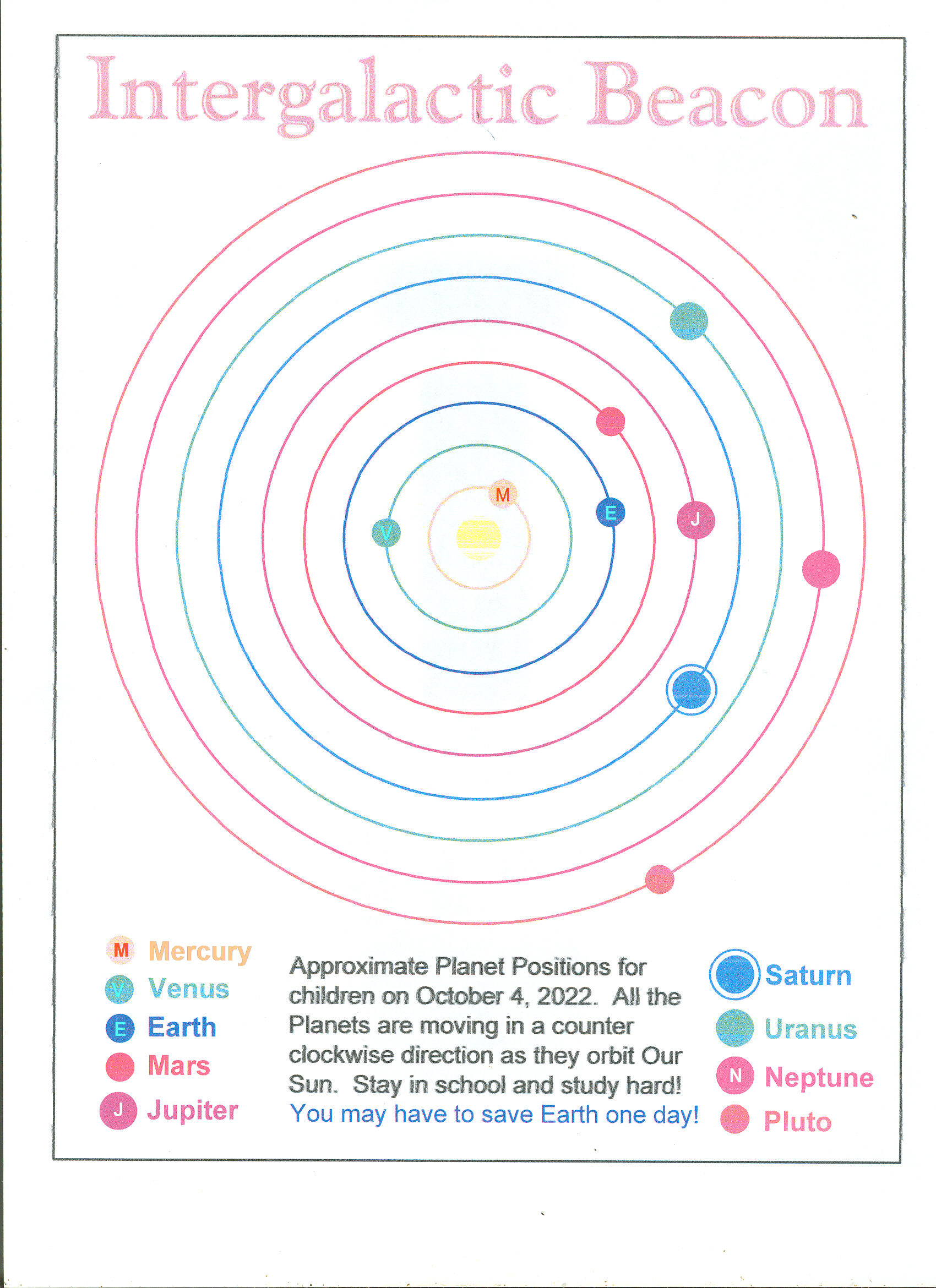 For a full size Printable copy click the underlined Solar System Sketch
Link at the start of this article. Click all the Unerlined Links in
this article for extra pictures and diagrams.
For a full size Printable copy click the underlined Solar System Sketch
Link at the start of this article. Click all the Unerlined Links in
this article for extra pictures and diagrams.
The Earth is the third Planet from the sun at a distance of 93 million
miles. Venus is the second planet at 67 million miles from the sun and 26
million miles from Earth. Mars is the fourth planet at 142 million miles
from the Sun and about 50 million miles from Earth. The position of the
rest of the planets can be seen from the Solar System sketch. All the
nine planets in our Solar System orbit the Sun in the same plane and in a
counter clockwise motion. So as you stand on the Surface of planet Earth,
you are actually moving 1,000 miles an hour toward the east as the Earth
rotates about it's axis, (creating day and night), and you are also moving
at 66,600 miles an hour counter clockwise as the Earth Orbits the Sun. As
you know the Earth takes one year to complete an orbit around the Sun, and
it takes 24 hours to make one revolution on its axis (one day). Our Milky
Way Galaxy also spins on its axis and it takes approximately 250 million
years for the Milky Way to complete one revolution. Now for some simple
size comparison between the planets. The Sun is of course the largest
body in our Solar System and Jupiter is the largest planet. It would take
about 1,300 Earths to fill Jupiter and about 1 million Earths to fill the
Sun. Also Earth and Venus are about the same size, but Earth is
almost twice as big as Mars. Read my Planets Article for more info on
the Planets including: size, rotation time, orbital speed, and a complete
list of known moons for each planet. Visit the NASA links from my list of
Favorite Links for more info.
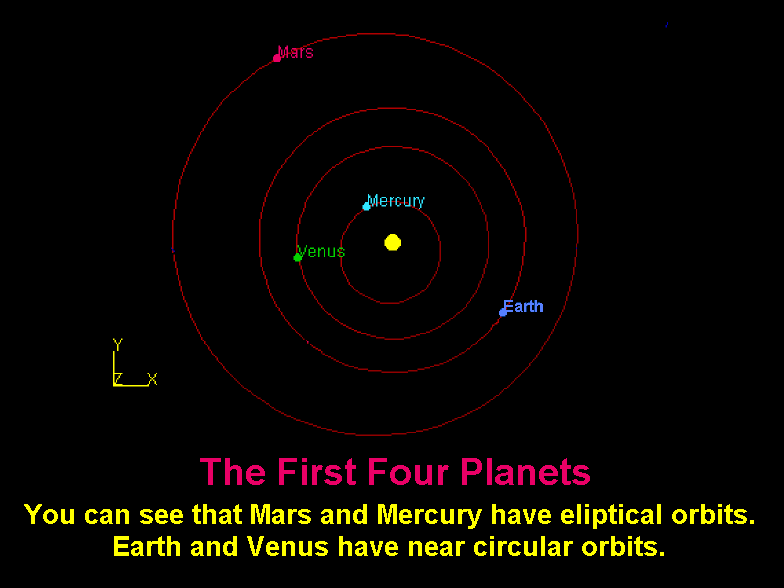 CLICK ALL THE UNDERLINED LINKS FOR DIAGRAMS LIKE THE ABOVE OR PICTURES
Now that you are familiar with our Solar System it is time to take the
next step and learn about our Galactic Home. Our Solar System is just one
of millions along with about 300 to 400 billion other Stars and huge
clouds of interstellar Dust and Gas that make up our Milky Way Galaxy. If
you go outside on a clear night, far from any artificial lighting, look
directly over head! You will see a dense Milky Like (cloudy like) band
crossing the night sky chock full of stars. The American Indians called
it the Back Bone of Night. You are looking at the Spiral Arm of our
Galaxy that the Earth and our Solar System reside in. If you live in the
southern hemisphere you have a very nice view of our Milky Way Galaxy.
Our Galaxy is a large mass of stars, gas, and dust all orbiting a giant
Galactic Core or center. Display Spiral Galaxy NGC7742 for a good example
of how a Galaxy looks from high overhead looking down perpendicular to its
rotational plane (like looking down on an egg frying sunny side up). The
Milky way is much like this but the Spiral arms of our galaxy extend
further from the center similar to those in Galaxy M-101 which you can
downloaded form the "pictures section" here on the Intergalactic Beacon.
Our Solar System resides in one of these Spiral Arms, and according to the
latest measurements we are about 25,000 light years from the center of our
Milky Way Galaxy.
CLICK ALL THE UNDERLINED LINKS FOR DIAGRAMS LIKE THE ABOVE OR PICTURES
Now that you are familiar with our Solar System it is time to take the
next step and learn about our Galactic Home. Our Solar System is just one
of millions along with about 300 to 400 billion other Stars and huge
clouds of interstellar Dust and Gas that make up our Milky Way Galaxy. If
you go outside on a clear night, far from any artificial lighting, look
directly over head! You will see a dense Milky Like (cloudy like) band
crossing the night sky chock full of stars. The American Indians called
it the Back Bone of Night. You are looking at the Spiral Arm of our
Galaxy that the Earth and our Solar System reside in. If you live in the
southern hemisphere you have a very nice view of our Milky Way Galaxy.
Our Galaxy is a large mass of stars, gas, and dust all orbiting a giant
Galactic Core or center. Display Spiral Galaxy NGC7742 for a good example
of how a Galaxy looks from high overhead looking down perpendicular to its
rotational plane (like looking down on an egg frying sunny side up). The
Milky way is much like this but the Spiral arms of our galaxy extend
further from the center similar to those in Galaxy M-101 which you can
downloaded form the "pictures section" here on the Intergalactic Beacon.
Our Solar System resides in one of these Spiral Arms, and according to the
latest measurements we are about 25,000 light years from the center of our
Milky Way Galaxy.

For a full size picture click the underlined Spiral Galaxy NGC7742 link
above. Click all underlined links for extra pictures and diagrams.
One Light Year = approximately 6 Trillion Miles, and is the distance
Light travels in one year. The Speed of Light is 186,200 Miles per
Second, so it only takes SunLight about 8.333 Minutes to reach Earth
93 million miles from the Sun.
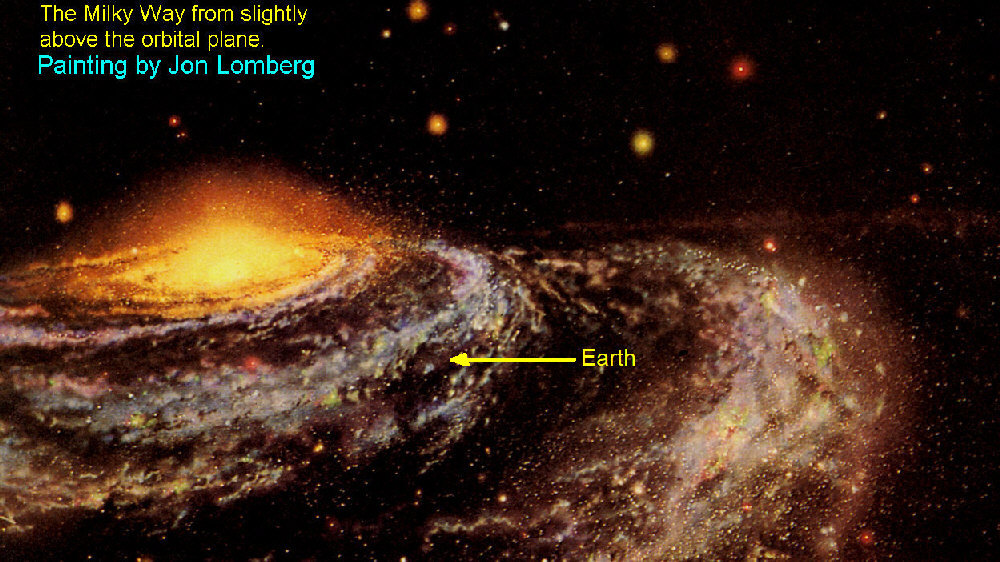 This Beautiful Painting by Jon Lomberg was done from data provided by NASA
in Radio, infrared, ultraviolet, and X-ray wavelengths as explained below
since dust clouds block our view toward the Galactic Core! If Our Solar
System were located at the Top of our Galactic Spiral Arm, or on the inside
of our Galactic Spiral Arm then the "Galactic Core" would rise in the Night
Sky and it would never be Truly Dark!!! One thing is for sure the awesom
Power of the Almighty Creator is there for ALL to See! The yellow arrow and
Earth lable are by yours truly from Galactic Maps and is approximate only.
Mighty are you oh GOD, for who can stand against the end of "Space-Time".
Our Galaxy is one of the largest in our local area of the Universe. Our
Milky Way measures 100,000 light years across but only about 2,000 light
years thick when viewed edge on. That means that even if you could travel
at the speed of light (186,200 Miles per Second) it would take you 100,000
years to fly from one side of the Milky Way to the other!
The reason we do not have a much better view of our own galaxy is the
large amount of interstellar Dust in our Galactic Spiral Arm, blocks our
view toward the center of the Galaxy in the direction of the constellation
Sagittarius. Thick Interstellar Dust also blocks our view in many other
directions where our own Galaxy is concerned. This forces our scientists
to use Radio, infrared, ultraviolet, and X-ray wavelengths to examine and
map the structure of our own Galaxy. They are not stopped by the dust like
visible light is. Use my Link to the Chandra X-ray Telescope to see a
picture of a Giant Star located near the Galactic Center a few months ago.
Just think of a Galaxy as a giant solar system with the bright center as
the sun and the masses of stars as the planets. Our Milky Way Galaxy is
part of a small cluster of about 29 Galaxies that astronomers call the
Local Group. Most of the others in the group are smaller and dimmer than
our Milky Way Galaxy. The Large Magellanic Cloud and the Small Magellanic
Cloud are two of these smaller dimmer Galaxies. The Tarantula Nebula
displayed on the Intergalactic Beacon is from a section of the Large
Magellanic Cloud Galaxy.
This Beautiful Painting by Jon Lomberg was done from data provided by NASA
in Radio, infrared, ultraviolet, and X-ray wavelengths as explained below
since dust clouds block our view toward the Galactic Core! If Our Solar
System were located at the Top of our Galactic Spiral Arm, or on the inside
of our Galactic Spiral Arm then the "Galactic Core" would rise in the Night
Sky and it would never be Truly Dark!!! One thing is for sure the awesom
Power of the Almighty Creator is there for ALL to See! The yellow arrow and
Earth lable are by yours truly from Galactic Maps and is approximate only.
Mighty are you oh GOD, for who can stand against the end of "Space-Time".
Our Galaxy is one of the largest in our local area of the Universe. Our
Milky Way measures 100,000 light years across but only about 2,000 light
years thick when viewed edge on. That means that even if you could travel
at the speed of light (186,200 Miles per Second) it would take you 100,000
years to fly from one side of the Milky Way to the other!
The reason we do not have a much better view of our own galaxy is the
large amount of interstellar Dust in our Galactic Spiral Arm, blocks our
view toward the center of the Galaxy in the direction of the constellation
Sagittarius. Thick Interstellar Dust also blocks our view in many other
directions where our own Galaxy is concerned. This forces our scientists
to use Radio, infrared, ultraviolet, and X-ray wavelengths to examine and
map the structure of our own Galaxy. They are not stopped by the dust like
visible light is. Use my Link to the Chandra X-ray Telescope to see a
picture of a Giant Star located near the Galactic Center a few months ago.
Just think of a Galaxy as a giant solar system with the bright center as
the sun and the masses of stars as the planets. Our Milky Way Galaxy is
part of a small cluster of about 29 Galaxies that astronomers call the
Local Group. Most of the others in the group are smaller and dimmer than
our Milky Way Galaxy. The Large Magellanic Cloud and the Small Magellanic
Cloud are two of these smaller dimmer Galaxies. The Tarantula Nebula
displayed on the Intergalactic Beacon is from a section of the Large
Magellanic Cloud Galaxy.
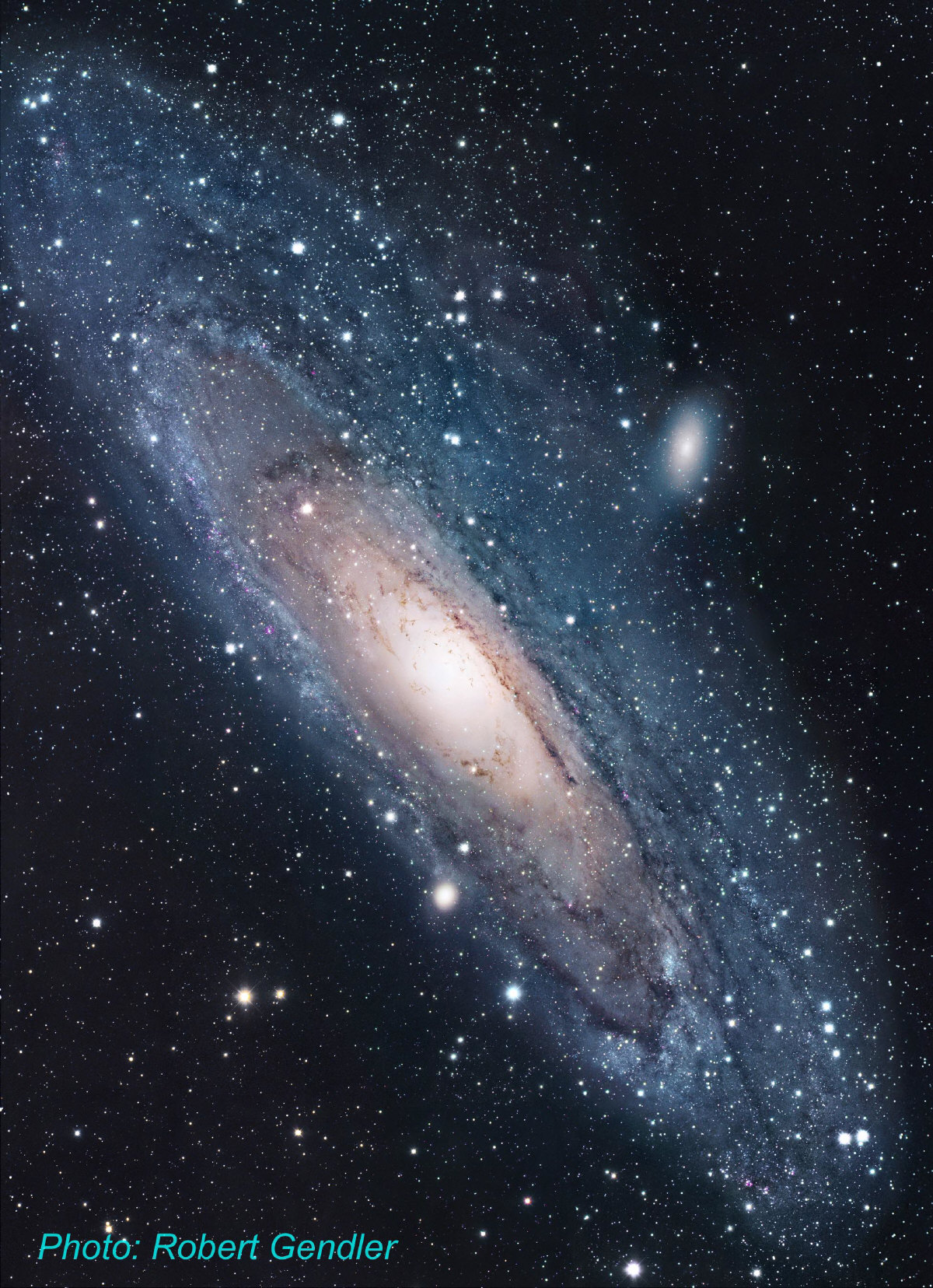
Galaxy Andromeda and a small companion galaxy is seen to the right of
center and about the same distance above center appearing as a white
fuzzy tennis ball like object. This small galaxy will be absorbed by
the Andromeda Galaxy. Four Bllion years from now Andromeda and our
Milky Way Galaxy will combine. May the FORCE be with you!
The only member, of the Local Group of 29 galaxies, larger than our Milky
Way is the Andromeda Galaxy (M-31) located at least 2 million light years
away. Andromeda is twice as big, at 200,000 light years wide and brighter
than the Milky Way, and has a larger, smoother, brighter Galactic Core or
(center) than our Milky Way. A picture of the Andromeda Galaxy (M-31)
can be downloaded from the "pictures section" here on the Intergalactic
Beacon. The last measurements I am aware of show that the Milky Way
Galaxy is moving, relative to the universe, in the same direction as
the constellation Leo lies relative to the Earth, and with a velocity of
more than 600 km/sec (373 miles/second). The Galaxy is also moving at
about 100 km/sec (62 miles per second), relative to the center of mass of
the local group of Galaxies.
Scientists are now sure of the presence of Black Holes in the Center of
many Galaxies they have observed, including some Spiral Galaxies like our
Milky Way Galaxy. Andrea Ghez and a team of others has now proved that our
Milky Way Galaxy does have a Black Hole at its center like all the other
galaxies we have checked on! The Black Holes diameter is about one AU
which is 93 million miles, which is the average distance from planet Earth
to our Sun. However, the Mass of the Black Hole is 4 Million times the
Mass of our Sun. Black Holes will be explained in a later article. For
now just think of them as a warped place in space that a massive star once
occupied, before collapsing in on itself. The Black Hole's gravity is so
Strong that even light cannot escape its pull!
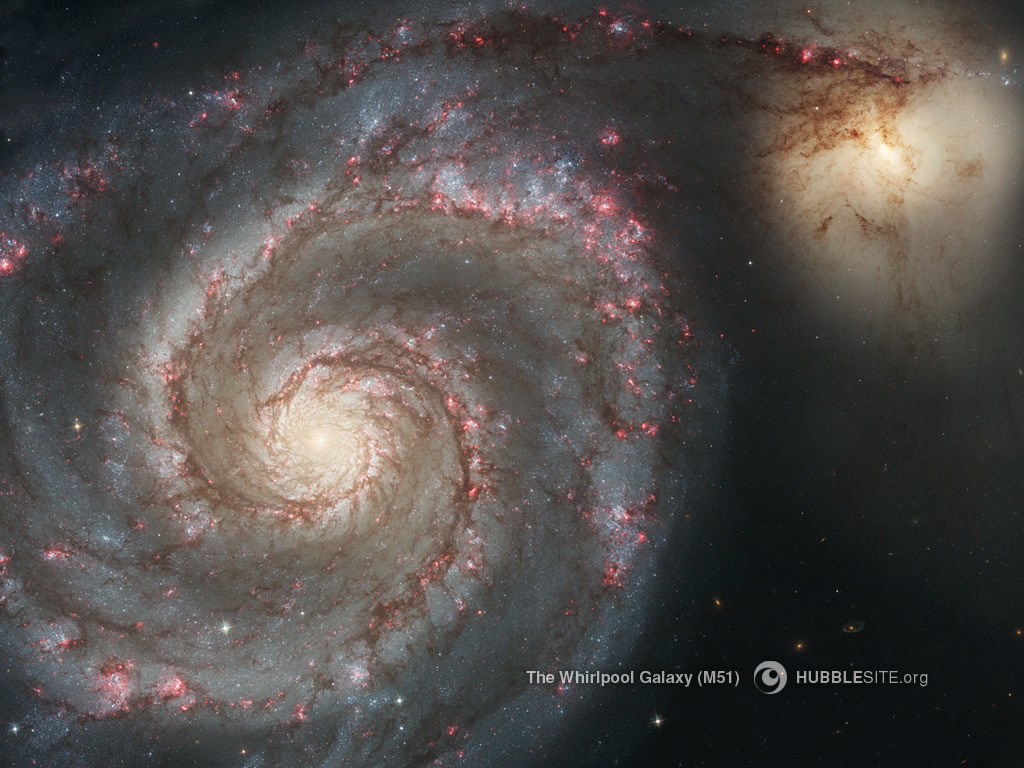
The Whirl Pool Galaxy M51, also known as NGC 5194, is having a very close
encounter with a nearby companion galaxy, NGC 5195, seen in the upper
right corner this image. The companion's gravitational pull is triggering
star formation in the main galaxy, as seen in brilliant detail by numerous
very luminous clusters of young and energetic stars. The bright clusters
are highlighted in red by their associated emission from glowing hydrogen
gas. The Whirlpool Galaxy is about 20 Million Light Years from Earth.
Now you have the basics of where you are in the Universe. You know the
Position of Planet Earth in the Solar System and in the Galaxy. Now when
you look at the sky at night it will have a lot more meaning for you.
Just think on planets around some of those stars you look at each night
Star Wars is going on right now! The Forces of good and evil battle
throughout the universe just as they do on planet Earth. May the FORCE be
with you! Live Long and Prosper! May HE whom the winds fear Light your
Path and Guide your Steps as You journey through this life.
Written by: The Galactic Sage
For a full size Printable copy click the underlined Solar System Sketch Link at the start of this article. Click all the Unerlined Links in this article for extra pictures and diagrams.
CLICK ALL THE UNDERLINED LINKS FOR DIAGRAMS LIKE THE ABOVE OR PICTURES Now that you are familiar with our Solar System it is time to take the next step and learn about our Galactic Home. Our Solar System is just one of millions along with about 300 to 400 billion other Stars and huge clouds of interstellar Dust and Gas that make up our Milky Way Galaxy. If you go outside on a clear night, far from any artificial lighting, look directly over head! You will see a dense Milky Like (cloudy like) band crossing the night sky chock full of stars. The American Indians called it the Back Bone of Night. You are looking at the Spiral Arm of our Galaxy that the Earth and our Solar System reside in. If you live in the southern hemisphere you have a very nice view of our Milky Way Galaxy. Our Galaxy is a large mass of stars, gas, and dust all orbiting a giant Galactic Core or center. Display Spiral Galaxy NGC7742 for a good example of how a Galaxy looks from high overhead looking down perpendicular to its rotational plane (like looking down on an egg frying sunny side up). The Milky way is much like this but the Spiral arms of our galaxy extend further from the center similar to those in Galaxy M-101 which you can downloaded form the "pictures section" here on the Intergalactic Beacon. Our Solar System resides in one of these Spiral Arms, and according to the latest measurements we are about 25,000 light years from the center of our Milky Way Galaxy.
This Beautiful Painting by Jon Lomberg was done from data provided by NASA in Radio, infrared, ultraviolet, and X-ray wavelengths as explained below since dust clouds block our view toward the Galactic Core! If Our Solar System were located at the Top of our Galactic Spiral Arm, or on the inside of our Galactic Spiral Arm then the "Galactic Core" would rise in the Night Sky and it would never be Truly Dark!!! One thing is for sure the awesom Power of the Almighty Creator is there for ALL to See! The yellow arrow and Earth lable are by yours truly from Galactic Maps and is approximate only. Mighty are you oh GOD, for who can stand against the end of "Space-Time". Our Galaxy is one of the largest in our local area of the Universe. Our Milky Way measures 100,000 light years across but only about 2,000 light years thick when viewed edge on. That means that even if you could travel at the speed of light (186,200 Miles per Second) it would take you 100,000 years to fly from one side of the Milky Way to the other! The reason we do not have a much better view of our own galaxy is the large amount of interstellar Dust in our Galactic Spiral Arm, blocks our view toward the center of the Galaxy in the direction of the constellation Sagittarius. Thick Interstellar Dust also blocks our view in many other directions where our own Galaxy is concerned. This forces our scientists to use Radio, infrared, ultraviolet, and X-ray wavelengths to examine and map the structure of our own Galaxy. They are not stopped by the dust like visible light is. Use my Link to the Chandra X-ray Telescope to see a picture of a Giant Star located near the Galactic Center a few months ago. Just think of a Galaxy as a giant solar system with the bright center as the sun and the masses of stars as the planets. Our Milky Way Galaxy is part of a small cluster of about 29 Galaxies that astronomers call the Local Group. Most of the others in the group are smaller and dimmer than our Milky Way Galaxy. The Large Magellanic Cloud and the Small Magellanic Cloud are two of these smaller dimmer Galaxies. The Tarantula Nebula displayed on the Intergalactic Beacon is from a section of the Large Magellanic Cloud Galaxy.




